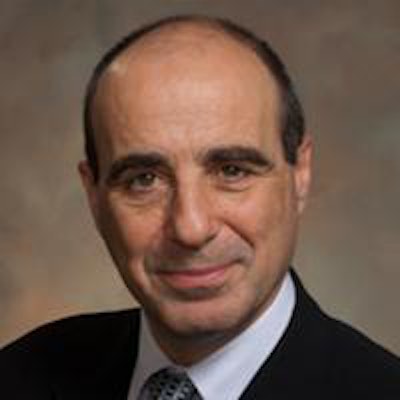
Obamacare is expected to have far-reaching effects on radiology and the rest of the healthcare delivery system, but the changes for providers are expected to be gradual, as the traditional fee-for-service structure is retained at most facilities.
So concluded a talk that looked at the impact of the Patient Protection and Affordable Care Act (PPACA) on radiology at the recent Virtual Symposium on Radiation Safety and Computed Tomography, which was sponsored by the University of California, San Francisco (UCSF).
The sweeping healthcare law, passed by a Democratic Congress in 2010 and upheld in large part by the U.S. Supreme Court last year, will wield its greatest impact on the lives of patients who currently lack coverage. An estimated 27 million will be added to the ranks of the insured through an expansion of Medicaid in states that choose to participate in the part of the expanded program to cover their poorest citizens.
For individuals on the next steps up the income ladder, federal subsidies averaging $5,000 to $6,000 will be provided to those earning from 138% to 400% of the federal poverty level, to a maximum of about $15,000 for individuals and nearly $31,000 for a family of four. PPACA rolls out in earnest next January, when individuals will start choosing from among several levels of insurance coverage, from bare-bones bronze to posh platinum, on websites that cater to each state. Smaller states will have fewer choices.
An individual mandate requires people to buy insurance through state healthcare exchanges if they do not already have it; the requirement is accompanied by an income tax penalty of 1% for noncompliance, rising to 2% in 2015. On the plus side for patients, already gone is insurance providers' ability to exclude those with pre-existing conditions. And children may now stay on their parents' health plans until the age of 26 years.
But what about physicians?
Far less publicized has been the provider side of the equation, which is anticipated to change dramatically, if gradually, according to Dr. Andrew Bindman. The first thing doctors can expect to receive is more money, tied to a series of new payment models that encourage cost-effective care, he said in his talk at the May symposium.
 Dr. Andrew Bindman of UCSF.
Dr. Andrew Bindman of UCSF.Currently, about 20% of all healthcare spending goes to physicians, but under PPACA, the total funds available for healthcare will rise. A back-of-the-envelope estimate suggests that doctors can expect about $30 billion in new funds in 2016, amounting to a "5% to 6% increase over what is currently directed toward physicians because of coverage expansion," according to Bindman, who is a professor of medicine and health policy at UCSF.
"The other major change is ... anticipated changes in the payment model for the Medicare program," namely "a decrease in the use of pure fee-for-service reimbursement though the Medicare program ... and enhanced use of performance-based incentives based on quality to try to reinforce quality through the payment mechanism," Bindman said.
A third cost-saving component will implement bundled payments to providers to pay for episodes of care in lump sums.
Providers will see plenty of strings attached to those dollars. Under the new regime, penalties will be levied, for example, on hospitals with high readmission rates, and for facilities whose patients turn up with hospital-acquired conditions.
PPACA will also change the organization of physicians through the payment model, Bindman said.
"Among the most dramatic examples of this are accountable care organizations, or ACOs," he said. "The performance-based changes are already beginning to happen through the Medicare program."
One new tool to encourage quality healthcare is the Physician Quality Reporting System (PQRS), a program that combines incentives to promote the reporting of quality information. For example, PQRS will dole out a 1.5% Medicare bonus to be implemented over time, Bindman said. In radiology, the maintenance of certification (MOC) requirement of the American Board of Radiology can be satisfied by reporting the radiation dose of studies.
ACOs represent "one of the most significant delivery system changes in health reform," Bindman said. The ACO provider networks assume responsibility for defined populations of at least 5,000 Medicare patients, and they are accountable for the costs as well as the quality of care for the population, sharing in the risks and the opportunities for profit through Medicare, he said.
Quality-monitoring systems
A perennial concern with handing out cost-cutting incentives is that providers could be stingy with care to boost the bottom line; however, PPACA has built-in quality-monitoring systems to discourage cost savings that could jeopardize the provision of quality care. And the performance measures that assess quality healthcare are expected to become more sophisticated over time "to provide confidence that savings are achieved by providing more care rather than by withholding the delivery of appropriate care for these patients," Bindman said.
Although ACOs may sound a lot like the old managed care programs, there are some important differences.
"First of all, payments in the ACO are tied to fee for service rather than capitation, which is more typical in managed care organizations," he said. "The fee-for-service mechanism in the ACOs is how they are designed now."
It's possible that it could change to a capitation model in the future, but for now the model runs on fee for service, he noted.
The second difference between ACOs and managed care organizations is that payments under fee for service are risk-adjusted based on historical costs for the ACO's particular population. Payments in managed care organizations were rarely adjusted for the health status of the population, Bindman said. And, as stated, ACO payments will depend significantly on the quality of care provided.
ACOs currently come in two models: the Medicare Shared Savings Program (MSSP), which comprises 220 ACOs, and so-called pioneer ACOs, of which there are just 32 right now.
"These organizations will be accountable for costs, as well as quality and overall care for the population," Bindman said. They allow providers to take on responsibilities and opportunities for financial risk sharing with the Medicare program.
MSSPs require a three-year minimum contract between the ACO and the U.S. Centers for Medicare and Medicaid Services (CMS), along with a minimum covered population of 5,000 insured lives. Inasmuch as Medicare patients can be treated wherever they wish, attribution of the contract and money paid on it is based on where the beneficiary receives most of his or her care, Bindman said. Payments for the first three years are based on historical costs, while the years going forward are based on projected costs, adjusted for national growth in Part A and Part B Medicare expenditures.
In MSSP, shared savings and losses are based on an annual comparison of per-capita spending with projected spending. If actual spending is less than projected spending, Medicare and the provider can share the savings that are above a certain percentage, say 2%, as long as the quality of care passes a raft of benchmarks.
Furthermore, there are two types of MSSPs: Track 1 MSSP programs guarantee against losses for the first three years, but they also limit the extent of profits. Track 2 MSSP programs come with an immediate downside risk of up to 60% of projected costs, so "ACOs may have to pay money back to Medicare if they do not come in below target amounts for their medical benefits," Bindman said.
Track 1 permits a maximum of 50% shared savings, up to 10% of total costs, he said. Track 2 permits a maximum of 60% shared savings, up to 15% of total costs, permitting greater potential gains along with the greater risk of loss. Finally, a track 1 program may convert to track 2 after the initial contract period, but not vice versa.
Pioneer ACOs have even more opportunities for advanced risk sharing than MSSPs. These plans must care for a minimum of 15,000 participants, and if they establish a two-year history of providing high-quality care for less than projected costs, they are granted the opportunity to switch from fee-for-service to capitation payments. By the second year, pioneer ACOs must set up a similar arrangement with a second payor.
"So unlike MSSPs, a pioneer ACO must become a multipayor provider and have at least one other payor with a similar kind of arrangement as they have going on with Medicare," Bindman said.
ACOs set radiology pay
It's important to remember that the payment arrangements for physicians within an ACO are determined by the ACO itself, Bindman said. And the new payment models could change the role of radiologists in the healthcare organization.
Medicare requires that a plan be in place ahead of time to determine how payments will be allocated.
"Under the ACO model, one could start to anticipate that radiology becomes more of a cost center than a revenue generator," Bindman said. "That raises important issues about the need for a business model for consultations that don't result in as many tests being ordered, particularly those that are less important or less necessary."
As a result, the need for research on appropriate use of imaging and its impact on outcomes can be expected to grow substantially to help the new ACOs make the most cost-effective use of radiology exams. Cost-effectiveness innovation is even accounted for in PPACA itself, which created a new organization called the Center for Medicare and Medicaid Innovation (CMMI).
"It's specifically mentioned that CMMI should study the use of varying payments for physicians according to their adherence to appropriateness criteria," Bindman said. "CMMI, which has a budget of $10 billion over the next 10 years, has an opportunity to do demonstrations of new patient models for affordable care -- and they've done two studies related to radiology."
This includes a Chicago research study with national radiology group Imaging Advantage: The $5.9 million project is using decision-support and immediate consultation on the front end of radiologic test ordering, i.e., before the scans are acquired.
In addition, the Altarum Institute in Detroit has embarked on an $8.4 million project to create a data exchange between primary care physicians and radiologists -- again, to promote evidence-based use of radiologic tests before they are carried out, Bindman said.
In general, payors looking to transition from a fee-for-service system that rewards volume to a payment system that rewards value will be receptive to reimbursing radiologists based on their ability to increase the safe and appropriate use of imaging studies, he said. From a broader perspective, increasing public and professional awareness about radiation safety will challenge clinicians to become more involved in determining the appropriate use of imaging in medicine.
"There is much underway and much changing because of PPACA," Bindman said.



















